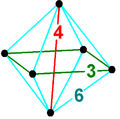Bitruncated tesseractic honeycomb
| Bitruncated tesseractic honeycomb | |
|---|---|
| (No image) | |
| Type | Uniform 4-honeycomb |
| Schläfli symbol | t1,2{4,3,3,4} or 2t{4,3,3,4} t1,2{4,31,1} or 2t{4,31,1} t2,3{4,31,1} q2{4,3,3,3,4} |
| Coxeter-Dynkin diagram |
|
| 4-face type | Bitruncated tesseract Truncated 16-cell |
| Cell type | Octahedron Truncated tetrahedron Truncated octahedron |
| Face type | {3}, {4}, {6} |
| Vertex figure |  Square-pyramidal pyramid |
| Coxeter group | = [4,3,3,4] = [4,31,1] = [31,1,1,1] |
| Dual | |
| Properties | vertex-transitive |
In four-dimensional Euclidean geometry, the bitruncated tesseractic honeycomb is a uniform space-filling tessellation (or honeycomb) in Euclidean 4-space. It is constructed by a bitruncation of a tesseractic honeycomb. It is also called a cantic quarter tesseractic honeycomb from its q2{4,3,3,4} construction.
Other names
- Bitruncated tesseractic tetracomb (batitit)
Related honeycombs
The [4,3,3,4], ![]()
![]()
![]()
![]()
![]()
![]()
![]()
![]()
![]() , Coxeter group generates 31 permutations of uniform tessellations, 21 with distinct symmetry and 20 with distinct geometry. The expanded tesseractic honeycomb (also known as the stericated tesseractic honeycomb) is geometrically identical to the tesseractic honeycomb. Three of the symmetric honeycombs are shared in the [3,4,3,3] family. Two alternations (13) and (17), and the quarter tesseractic (2) are repeated in other families.
, Coxeter group generates 31 permutations of uniform tessellations, 21 with distinct symmetry and 20 with distinct geometry. The expanded tesseractic honeycomb (also known as the stericated tesseractic honeycomb) is geometrically identical to the tesseractic honeycomb. Three of the symmetric honeycombs are shared in the [3,4,3,3] family. Two alternations (13) and (17), and the quarter tesseractic (2) are repeated in other families.
| C4 honeycombs | |||
|---|---|---|---|
| Extended symmetry |
Extended diagram |
Order | Honeycombs |
| [4,3,3,4]: | ×1 | ||
| [[4,3,3,4]] | ×2 | ||
| [(3,3)[1+,4,3,3,4,1+]] ↔ [(3,3)[31,1,1,1]] ↔ [3,4,3,3] |
↔ ↔ |
×6 | |
The [4,3,31,1], ![]()
![]()
![]()
![]()
![]()
![]()
![]() , Coxeter group generates 31 permutations of uniform tessellations, 23 with distinct symmetry and 4 with distinct geometry. There are two alternated forms: the alternations (19) and (24) have the same geometry as the 16-cell honeycomb and snub 24-cell honeycomb respectively.
, Coxeter group generates 31 permutations of uniform tessellations, 23 with distinct symmetry and 4 with distinct geometry. There are two alternated forms: the alternations (19) and (24) have the same geometry as the 16-cell honeycomb and snub 24-cell honeycomb respectively.
| B4 honeycombs | ||||
|---|---|---|---|---|
| Extended symmetry |
Extended diagram |
Order | Honeycombs | |
| [4,3,31,1]: | ×1 | |||
| <[4,3,31,1]>: ↔[4,3,3,4] |
↔ |
×2 | ||
| [3[1+,4,3,31,1]] ↔ [3[3,31,1,1]] ↔ [3,3,4,3] |
↔ ↔ |
×3 | ||
| [(3,3)[1+,4,3,31,1]] ↔ [(3,3)[31,1,1,1]] ↔ [3,4,3,3] |
↔ ↔ |
×12 | ||
There are ten uniform honeycombs constructed by the Coxeter group, all repeated in other families by extended symmetry, seen in the graph symmetry of rings in the Coxeter–Dynkin diagrams. The 10th is constructed as an alternation. As subgroups in Coxeter notation: [3,4,(3,3)*] (index 24), [3,3,4,3*] (index 6), [1+,4,3,3,4,1+] (index 4), [31,1,3,4,1+] (index 2) are all isomorphic to [31,1,1,1].
The ten permutations are listed with its highest extended symmetry relation:
| D4 honeycombs | |||
|---|---|---|---|
| Extended symmetry |
Extended diagram |
Extended group |
Honeycombs |
| [31,1,1,1] | (none) | ||
| <[31,1,1,1]> ↔ [31,1,3,4] |
↔ |
×2 = | (none) |
| <2[1,131,1]> ↔ [4,3,3,4] |
↔ |
×4 = | |
| [3[3,31,1,1]] ↔ [3,3,4,3] |
↔ |
×6 = | |
| [4[1,131,1]] ↔ [[4,3,3,4]] |
↔ |
×8 = ×2 | |
| [(3,3)[31,1,1,1]] ↔ [3,4,3,3] |
↔ |
×24 = | |
| [(3,3)[31,1,1,1]]+ ↔ [3+,4,3,3] |
↔ |
½×24 = ½ | |
See also
Regular and uniform honeycombs in 4-space:
- Tesseractic honeycomb
- Demitesseractic honeycomb
- 24-cell honeycomb
- Truncated 24-cell honeycomb
- Snub 24-cell honeycomb
- 5-cell honeycomb
- Truncated 5-cell honeycomb
- Omnitruncated 5-cell honeycomb
Notes
References
- Kaleidoscopes: Selected Writings of H. S. M. Coxeter, edited by F. Arthur Sherk, Peter McMullen, Anthony C. Thompson, Asia Ivic Weiss, Wiley-Interscience Publication, 1995, ISBN 978-0-471-01003-6
- George Olshevsky, Uniform Panoploid Tetracombs, Manuscript (2006) (Complete list of 11 convex uniform tilings, 28 convex uniform honeycombs, and 143 convex uniform tetracombs)
- Klitzing, Richard. "4D Euclidean tesselations#4D". x3x3x *b3o *b3o , x3x3x *b3o4o , o3x3o *b3x4o , o4x3x3o4o - batitit - O92
- Conway JH, Sloane NJH (1998). Sphere Packings, Lattices and Groups (3rd ed.). ISBN 0-387-98585-9.
| Fundamental convex regular and uniform honeycombs in dimensions 3–10 (or 2-9) | |||||
|---|---|---|---|---|---|
| Family | / / | ||||
| Uniform tiling | {3[3]} | δ3 | hδ3 | qδ3 | Hexagonal |
| Uniform convex honeycomb | {3[4]} | δ4 | hδ4 | qδ4 | |
| Uniform 5-honeycomb | {3[5]} | δ5 | hδ5 | qδ5 | 24-cell honeycomb |
| Uniform 6-honeycomb | {3[6]} | δ6 | hδ6 | qδ6 | |
| Uniform 7-honeycomb | {3[7]} | δ7 | hδ7 | qδ7 | 222 |
| Uniform 8-honeycomb | {3[8]} | δ8 | hδ8 | qδ8 | 133 • 331 |
| Uniform 9-honeycomb | {3[9]} | δ9 | hδ9 | qδ9 | 152 • 251 • 521 |
| Uniform 10-honeycomb | {3[10]} | δ10 | hδ10 | qδ10 | |
| Uniform n-honeycomb | {3[n]} | δn | hδn | qδn | 1k2 • 2k1 • k21 |